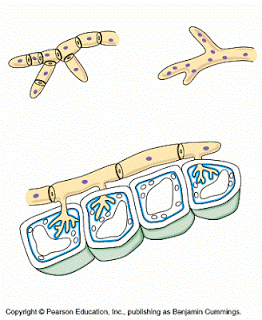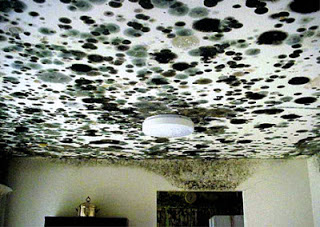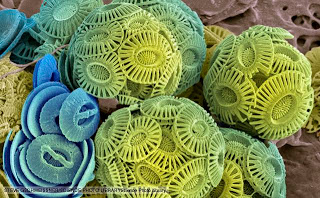Biology
Biology Concepts ? mold, fungus, powdery mildew, downy mildew, nosocomial infection, decomposer, parasite
I wish I had a nickel for every time my mother told me she was ?sick and tired? of picking up after me, or of telling me to clean my room. I might have a lot of nickels, but she?d still have been right. Sick always goes with tired, as if having two descriptors makes it more believable.
The bathroom is almost always a target for people selling you things to eradicate mold and mildew. Why the bathroom ? humidity is key for mold growth. This is why they sell better breads in paper packaging. The paper allows the moisture to escape and keeps the bread mold free for a longer period of time.
In addition, the S. marcescens bacterium was first associated with nosocomial infections in the 1950?s. Nosocomium is the Latin word for hospital, so nosocomial infections are those that you contract while in the hospital. Before the advent of hygienic and antiseptic practices in the very late 1800?s, hospitals were the last place you wanted to be if you were sick. You entered with a hangnail and left on a slab from the plague you picked up there.
It?s not all bad news, prodigiosin pigment is a potential new, antibacterial, pain, antifungal, immunosuppressive and anticancer drug. A 2013 study showed that purified S. marcescens prodigiosin kills several drug-resistant bacteria strains. The researchers determined that prodigiosin is pro-apoptotic (it makes the cell kill itself) and is not affected by the multidrug resistance transporter, so it could be a great cancer drug too. Even bad guys have good days.
There are wheat mildews, grape mildews, melon mildews etc. and each may require a different treatment. The hyphae attach to the leaf or the fruit and suck out the nutrients they need. This can?t be good for the plant.
Now the fungi have been joined to animals in the supergroup Unikonta (one flagellum). You see now why some many fungal drugs are useful for us, fungi are more closely related to us than they are to plants.
Under some new phylogeny schemes, downy mildew organisms are completely unrelated to fungal powdery mildew organisms, which are only distantly related to the organisms that cause some molds. The Tilex people have no idea what a box of worms they?ve opened.
Next week, let's examine your fingernails and toenails. If they are made from the same thing as hair, why are they so tough?
Elahian, F., Moghimi, B., Dinmohammadi, F., Ghamghami, M., Hamidi, M., & Mirzaei, S. (2013). The Anticancer Agent Prodigiosin Is Not a Multidrug Resistance Protein Substrate DNA and Cell Biology, 32 (3), 90-97 DOI: 10.1089/dna.2012.1902
Rehman, T., Moore, T., & Seoane, L. (2012). Serratia marcescens Necrotizing Fasciitis Presenting as Bilateral Breast Necrosis Journal of Clinical Microbiology, 50 (10), 3406-3408 DOI: 10.1128/JCM.00843-12
- Some Living Descriptions
Protista- unicellular eukaryotes, some multicelled formscell sturcture simple to very complexsome heterotrophs- protozoanssome autotrophs- algaeasexual repro, some both sexual, asexualmotile, non-motile, sizes- most microscopic but some may be 100m in...
- Fungus
Word: fungus (pl fungi) Origin: Latin fungus (mushroom) < Greek word sphongos/??????? (=sponge) because of the fungi appearance, Coined: Horace (65 BC ? 8 BC), and Pliny (23 AD ? 79AD), Definition: eukaryotic organisms...
- How Slime Molds Our World
Biology concepts ? Protista, fungus-like protists, penicillin, undulipodia, serendipity, potato famine, networks, co-evolution, slime mold It?s one thing for Dr. Fleming to have discovered pencillin by accident. It?s another to admit to everyone...
- It?s A Plant World, We?re Just Living In It
Biology concepts ? cell walls, chloroplasts, myco-heterotrophs, holoparasites, Life on Earth is easy. It can be boiled down to three sentences. ?The mitochondria and the chloroplasts are, in a fundamental sense, the most important things on Earth. Between...
- I?m Likin? The Lichen
Biology Concepts ? symbiosis, mutualism, lichens The lycan is a subject better relegated a cryptozoology blog. Along with the Loch Ness Monster, vampires, and the Easter Bunny, cryptids are those animals for whom there is little or no solid evidence,...
Biology
Mildew Broke The Mold
Biology Concepts ? mold, fungus, powdery mildew, downy mildew, nosocomial infection, decomposer, parasite
 |
Bill Cosby is one of the five funniest men ever. The other four, in no particular order, are of course, Jonathan Winters, Steve Martin, Groucho Marx, and Benny Hill. You might sub in Robin Williams for Benny?. maybe. |
Mold and mildew is another example of how one problem or explanation just isn?t enough. How many commercials have you seen for products that will rid your bathroom of mold andmildew? On the other hand, ever see a commercial for something that rids you of just mildew?
Question of the Day: Is mildew different than mold?
Molds are something we can identify with, we see mold on bread, oranges, and other things left around the kitchen for too long; they?re caused by many species of fungus.
Penicillin and many antifungal drugs come from molds, so they can be useful. We get a lot of our antibiotics from fungi because they are attacked by many of the same kinds of bacteria that attack us. The difference is that they have developed specific chemical defenses while we haven?t.
Fungi are closely related to animals, much more closely related to us than they are plants. This takes many people by surprise, especially since the internet is rife with websites that call fungus a form of plant life. Many fungi are decomposers, meaning that they gather their nutrients from dead organic material, but some are parasites of living things.
Mold fungi look very different from the mushroom fruiting bodies we normally picture when someone says fungus. However, they are very similar at the cellular level. Filamentous hyphae (singular form is hypha) are the key; these are the long lines of cells (filaments) that form the structure of the fungus before it forms fruiting bodies. In mold fungi, the fruiting bodies are usually spore-forming structures that are too small to be seen.
The hyphae form chains, some of spectacular length. When the hyphae branch, cross each other, form communications, and become sufficiently dense, they are called a mycelium. This is when you can see them. Even with mushroom fungi, it is the mycelium that lies just under the surface of the dirt that gathers the nutrients and connects the mushrooms together. Sometimes the mycelium is in your bathroom.
 |
Fungal hyphae come as septate (top left) or coenocytic (top right). Coenocytic are really multinucleate giant cells, while the septa may or may not divide the cells completely. The rhizoid is the projection that anchors the hypha to a food source, and pulls in nutrients. In decomposing fungi, the rhizoid attaches to something dead; in parasitic fungi, they burrow into live tissue. |
Bathrooms are the perfect combination of heat and humidity for promoting mold growth. All that is needed is a surface that the mold fungus can colonize. The rhizoid of the fungus is a short hyphal structure that attaches the fungus to its substrate. It also has the ability to absorb nutrients from the substrate like the rest of the hyphae.
Ceramic tile is designed to have a very smooth, flat surface with few pores. This makes it hard for mold rhizoids to attach and stick to tile. But grout and caulk are more porous and irregularly surfaced, so mold is more likely to gain an attachment and colonize these surfaces. The black mold that you see in showers is most likely going to be in vertical or horizontal lines where the tiles meet.
There is more than one type of black mold; one is common, and the other is toxic. Stachybotrys chartarum is one of the most toxic species. It is often associated with wet drywall conditions. Non-toxic black mold is caused by many different species and is more common on caulk and grout.
While black mold is the most common version seen in the bathroom, pink mold is probably second most common. This is our first exception of the day, since pink mold isn?t mold at all. It?s a bacterium called Serratia marcescens, which produces a red or pink pigment called prodigiosin (more about this below). The slimy film in your bathroom is the bacterial colony that feeds on fatty residues and phosphates, things found in soaps and shampoos.
 |
Toxic black mold (Stacchbyotrys species) can cause internal bleeding, infertility, and respiratory problems. No wonder they call it ?sick building syndrome.? I can?t imagine how someone could let it get this bad, but it needn't be like this for it to be causing you trouble. It could be under the paint or wallpaper. Thank goodness, most black mold is not the toxic variety. |
In addition, the S. marcescens bacterium was first associated with nosocomial infections in the 1950?s. Nosocomium is the Latin word for hospital, so nosocomial infections are those that you contract while in the hospital. Before the advent of hygienic and antiseptic practices in the very late 1800?s, hospitals were the last place you wanted to be if you were sick. You entered with a hangnail and left on a slab from the plague you picked up there.
Today there are many marcescens strains that are resistant to anti-bacterial drugs. It is becoming a big enough problem that some cases of necrotizing fasciitis (flesh-eating bacterial infections) are being blamed on resistant S. marcescens strains. While not common, about 25% of people who contract flesh-eating disease will die from it, and many are otherwise healthy, if you overlook the bacterial infection that is destroying large parts of their body.
Although S. marcescens is a rare cause of this horrible disease, there are about 20 cases in the literature, brought about by such diverse things as a human bite, contamination of a portal for leukemia drug injection, and immunosuppression. Makes you think about cleaning your shower better, doesn?t it.
 |
Joseph Lister was a British surgeon who thought it might be a good idea to keep open wounds and operating rooms clean. Listerine was named for him, but not invented by him. Listerine was produced by Jordan Wheat Lambert in St. Louis, MO. He traveled to England to get Lister?s approval to use the name. He thought it would sell better. Lambert?s son was a financial backer of Charles Lindbergh?s transatlantic flight; the St. Louis airport is named for him. |
So now we know that your bathroom mold is only sometimes mold. What about the mildew part of, ?mold and mildew?? When it comes to your bathroom cleaning, mildew is just a throw in, an advertising ploy.
Some mildews are indeed caused by fungi. Fungal mildews usually require organic surfaces to draw nutrients from. Paper will mildew, wood will mildew, so will drywall (wallboard, plasterboard) since it is paper backed. Clothes made of cotton or other natural fibers will mildew, as will leather. But, unless you have a cotton shower curtain, the most likely place you?ll find mildew in the bathroom is your towels.
If mildews like this are fungi, what makes them different from molds? In most cases, it is the degree of growth. Mildews are just not quite as bulky as molds. If a mildew grows for a long time and achieves greater density and mass, it is often called a mold.
However, in the vast majority of cases, mildews are problems of plants, not bathrooms. Plant mildews come in two primary types, powdery mildew and downy mildew. Neither is likely to be found in your shower unless it is so dirty that you actually have plants growing from your grout.
Mildews require living cells to parasitize; they aren?t decomposers, but obligate parasites. Both powdery and downy mildew are problems of horticulture. While they may not directly kill crops, they can reduce yields and make them more susceptible to other infections. In the great majority of cases, fungi that cause powdery mildew are plant specific, there are thousands of species, each attacking a specific plant.
The physical difference between powdery and downy mildew is seen above. Powdery is well, more powdery. It looks fuzzier because it grows higher off the surface. Downy mildew usually turns the leaf yellow or brown. There are often plant specific, but in both cases above, it's a grape leaf that is infected. |
If powdery mildew is a fungus, but only grows on living organisms, what does this make fungal infections of humans; are they more like molds or mildews? There was an incident in Maine in 2005 after it rained for many days in a row. Doctors started seeing fungal growths in the ears of inhabitants (would they be called Maineiacs?), primarily in their outer ears. This was fungal and was a form of human mildew, and overgrowth of normal fungal flora.
What about athlete?s foot? Is athlete?s foot, toenail fungus, or trench foot really just foot mildew? I suppose it just wouldn?t be polite to tell someone they were mildewing, so we call them fungal infections.
Another exception - downy mildew isn?t even a fungus. The causative organisms are oomycetes, a type of false fungus. Having ?mycete? in the name makes it sound like they are fungi, and they used to be categorized with the fungi. New naming systems have altered what is or isn?t a fungus based on shared DNA.
 |
This is a coccolithophore, a member of the chromalveolata, the supergroup that also includes downy mildew oomycetes. They live in the oceans and die in the trillions each day. The plates are made from calcium carbonate, so they fall to the bottom and become limestone or chalk. They might end up as drywall that could mildew. It?s a circle of life sort of thing. |
Next week, let's examine your fingernails and toenails. If they are made from the same thing as hair, why are they so tough?
Elahian, F., Moghimi, B., Dinmohammadi, F., Ghamghami, M., Hamidi, M., & Mirzaei, S. (2013). The Anticancer Agent Prodigiosin Is Not a Multidrug Resistance Protein Substrate DNA and Cell Biology, 32 (3), 90-97 DOI: 10.1089/dna.2012.1902
Rehman, T., Moore, T., & Seoane, L. (2012). Serratia marcescens Necrotizing Fasciitis Presenting as Bilateral Breast Necrosis Journal of Clinical Microbiology, 50 (10), 3406-3408 DOI: 10.1128/JCM.00843-12
- Some Living Descriptions
Protista- unicellular eukaryotes, some multicelled formscell sturcture simple to very complexsome heterotrophs- protozoanssome autotrophs- algaeasexual repro, some both sexual, asexualmotile, non-motile, sizes- most microscopic but some may be 100m in...
- Fungus
Word: fungus (pl fungi) Origin: Latin fungus (mushroom) < Greek word sphongos/??????? (=sponge) because of the fungi appearance, Coined: Horace (65 BC ? 8 BC), and Pliny (23 AD ? 79AD), Definition: eukaryotic organisms...
- How Slime Molds Our World
Biology concepts ? Protista, fungus-like protists, penicillin, undulipodia, serendipity, potato famine, networks, co-evolution, slime mold It?s one thing for Dr. Fleming to have discovered pencillin by accident. It?s another to admit to everyone...
- It?s A Plant World, We?re Just Living In It
Biology concepts ? cell walls, chloroplasts, myco-heterotrophs, holoparasites, Life on Earth is easy. It can be boiled down to three sentences. ?The mitochondria and the chloroplasts are, in a fundamental sense, the most important things on Earth. Between...
- I?m Likin? The Lichen
Biology Concepts ? symbiosis, mutualism, lichens The lycan is a subject better relegated a cryptozoology blog. Along with the Loch Ness Monster, vampires, and the Easter Bunny, cryptids are those animals for whom there is little or no solid evidence,...
